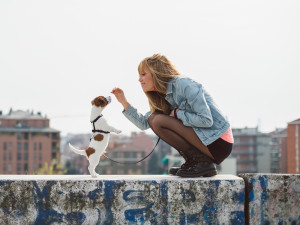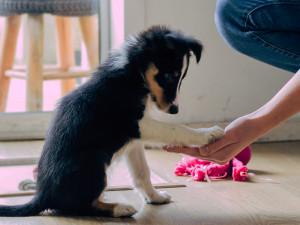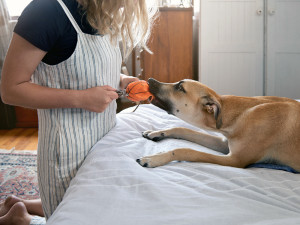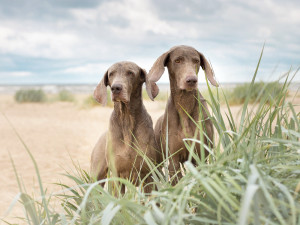A Crash Course On Dog Agility Training
Five reasons to get your dog in the agility game, from burning energy to building confidence

Share Article
Ever watch a Westminster agility champ fly through the obstacles with precision and think: ‘My dog could do that’? Or cry laughing when some less-than-graceful dog launches into the course with joyful abandon, doing whatever they please? If either scenario resonates, agility training might be the perfect exercise for you and your dog to do together.
What is agility training?
It’s learning and practising the physical and mental skills behind a fun, often fast-paced sport that involves both you and your dog working as a seamless duo. If we had you until ‘seamless’, not to worry: getting there together is half the fun and a great way to deepen the bond with your dog. In agility training, there’s typically an obstacle course that your dog runs through with you as their hype person, and where the fastest time wins – if you’re competing professionally, that is. Agility training isn’t just for Westminster, though. It can be done in the comfort of your home or backyard with easy-to-find obstacles, from tunnels to hoops to weave poles. Or, forget the equipment and just teach your dog to weave through your legs. It all counts in our book.
Agility works for pretty much every dog, no matter the breed, size or age. If your dog is social, physically fit and likes to learn, they will most likely enjoy agility. Older dogs or certain breeds that may normally be characterised as couch potatoes come to life when given extra attention and mental and physical stimulation from agility.
Benefits of agility training
Whatever your dog’s end goal – championship dreams or soul-satisfying good times – the potential benefits are the same. There are plenty of ways you can use agility training to help your dog thrive well beyond the course.
1. Physical and mental exercise
Walking is great, sure, but it’s usually not enough stimulation for our dogs. Agility works both physically and mentally to stimulate and tire our dogs out in the best way. Learning how to get your dog to go over, under, around or through different obstacles as you call out directions, while running to keep up with them, is the best kind of all-purpose exercise for you both. But you don’t have to be a track star, and your dog doesn’t have to be a Border Collie. Any breed or mix with an eager-to-please attitude can discover that agility is their thing. One key requirement is a foundation of good health – younger dogs or breeds prone to joint injuries should take it slow to avoid risk to vulnerable areas and muscles.
2. Healthy weight and mobility
You can’t have agility without ‘agile’. It’s all about the base – teaching your dog to be aware of their back end helps keep their body in great working order. They need to know how to keep their back paws close to obstacles to get around them efficiently. A good trainer will show you how to support your dog’s smooth, safe movement for agility now and healthy mobility long-term. It’s a role that should also include keeping your dog in great shape – maintaining a healthy weight, and taking time to warm up and cool down before and after training. Small disclaimer: there are no guarantees your dog’s new back-end control will prevent happy tail wags knocking wine glasses from surrounding coffee tables.
3. Refresh basic commands
The good news is agility training doesn’t require your dog (or you) to have any specific skills before you start. But it is helpful to at least have an understanding of basics like sit, down, watch me and stay. Here’s your chance to refresh simple skills they already know, letting the treats flow to celebrate, and bask in your dog’s every success.
4. Strengthens bond
Agility is 100 percent present time with your dog. No mobile phones, no distractions. Totally tuning in to them makes it possible to start thinking and moving as one. Your dog will be in heaven, and you’ll develop an unspoken language between you that, while it may not fulfil the dream of them speaking English, makes all the other parts of your life together more magical. Spending extra time training your dog will teach you a lot about their personality as well as strengthen the bond between you. Find out what motivates them most: toys, praise, food or a combination?
5. Builds confidence and lowers anxiety
Agility training might be the perfect way to give fearful dogs their moment. Although it isn’t an absolute cure for fearfulness or other issues like separation anxiety and reactivity, it can build confidence, which, in turn, lowers anxieties. Learning life skills in a playful way allows your pup to shed stress. And because agility training requires using their minds, dogs will expend energy quicker and be less able to focus on things they perceive as scary. Most of all, teaching them through positive reinforcement tells them we have their backs, always. Pro tip: if your dog isn’t a fan of other dogs, you’ll want to start with private sessions or on familiar turf.
How to get started
If you and your dog are new to agility, it’s helpful to start by finding a local agility training class and trainer. Look for one that is founded in positive-reinforcement, reward-based training. Watch out for euphemisms like ‘balanced training’ that include negative methods and force correction tools. Any hint of negativity, fear or force creates the opposite of the successful experience you’re going for with your dog. Check certifications and ask questions of your potential trainer. You want to be sure you’re getting someone who knows what they’re talking about, is staying up-to-date on the best science-based training methods, and won’t push your dog past the threshold.
Once you start, move at your dog’s pace: if your pup is the nervous type, start with just one obstacle, then try again another day. Use treats and toys freely to reinforce the behaviours you’re asking them to accomplish on the course. Above all, remember that your biggest reason for doing agility is growing your bond with your dog, so have fun and enjoy the windy road together.
Choosing an agility class
Julia Lane, the owner of Spot On K9 Sports, shares her tips on finding a class that meets your and your dog’s unique needs. Here are three main considerations for choosing the best match:
The environment. When you enter the agility training facility ��– whether it’s a snazzy indoor training school or a fenced-off grassy field – take a look around. Is the equipment in good shape? What kind of flooring is used? Artificial turf or thick rubber matting made especially for performance sports helps ensure that you and your dog won’t get hurt.
The instructor. Even if you know nothing about agility, you will have a gut reaction to what you see. If the instructor yells or students look stressed or frustrated, obviously no one is having fun. Look for an instructor who communicates well with the students and gives equal attention to each dog-handler team.
The dogs. How many dogs are in the class? Is there a lot of down time? How often does each dog get a turn? Is safety stressed by the instructor? You don’t want a beginning or ‘green’ dog to jump full height or go over obstacles like the A-frame or dog walk at full height. Also, only one dog should be off lead at a time, even at the most advanced levels.
Using dog agility equipment
The A-frame is a tall, wooden or aluminium structure whose apex is typically set at 1.7m.
The dog walk is a raised, narrow plank that the dog must cross as quickly as possible without sacrificing safety or missing the contact zone on the exit ramp.
The pause table is a raised platform upon which the dog must do a sit-stay or a down-stay.
Jumps are self-explanatory, though there are quite a variety of them. They range from the simple bar jump (imagine a hurdle jump) and the wide boards on the ground that comprise the broad jump to the winged jump, which is a bar jump with plastic lattice ‘wings’ on either end.
There are two different kinds of tunnels. The open tunnel is a tube through which the dog runs as fast as possible. The closed tunnel, or chute, looks like a giant wind sock. The dog must run through it in order to push up the material and exit.
The weave poles are challenging for dogs to learn because the weaving motion is unnatural to them. Twelve upright poles, each attached to a heavy steel base, are set out in a row.

Karen Chapdelaine, CPDT-KA
Karen Chapdelaine is a Certified Professional Dog Trainer (CPDT-KA) and Dogly Training Advocate. She specializes in helping dogs make peace with the world around them and learn how to enjoy being a dog, just like she did with her dog CJ.
Related articles
![Dog resting on a computer laptop]()
Are Gamer Dogs On the Horizon?
Don’t just assume that your dog’s golden years should be spent quietly relaxing – they could be gaming
![Border Collie puppy shaking owner's hand]()
The Go-To Training Schedule For Your Puppy
Your puppy training schedule, from eight weeks to six months. Let’s do this
![A blonde woman wearing a black t-shirt and striped overalls playing tug with her tan dog using an orange basketball squeaky toy]()
Playing Tug With Your Dog Is Good Exercise For Both of You
The basics of the tug game and how to trouble-shoot common problems
Male Vs Female Dogs: Are There Any Real Differences?
World-renowned behaviourist Patricia McConnell explains





